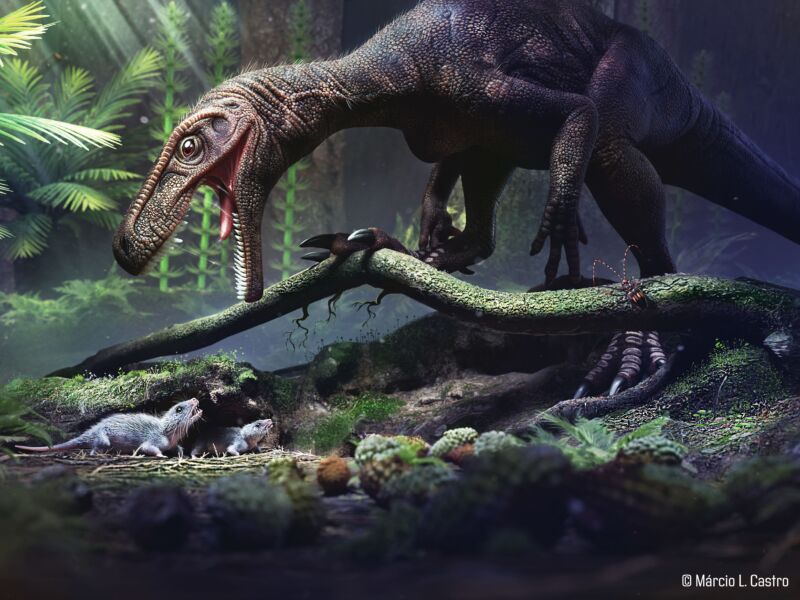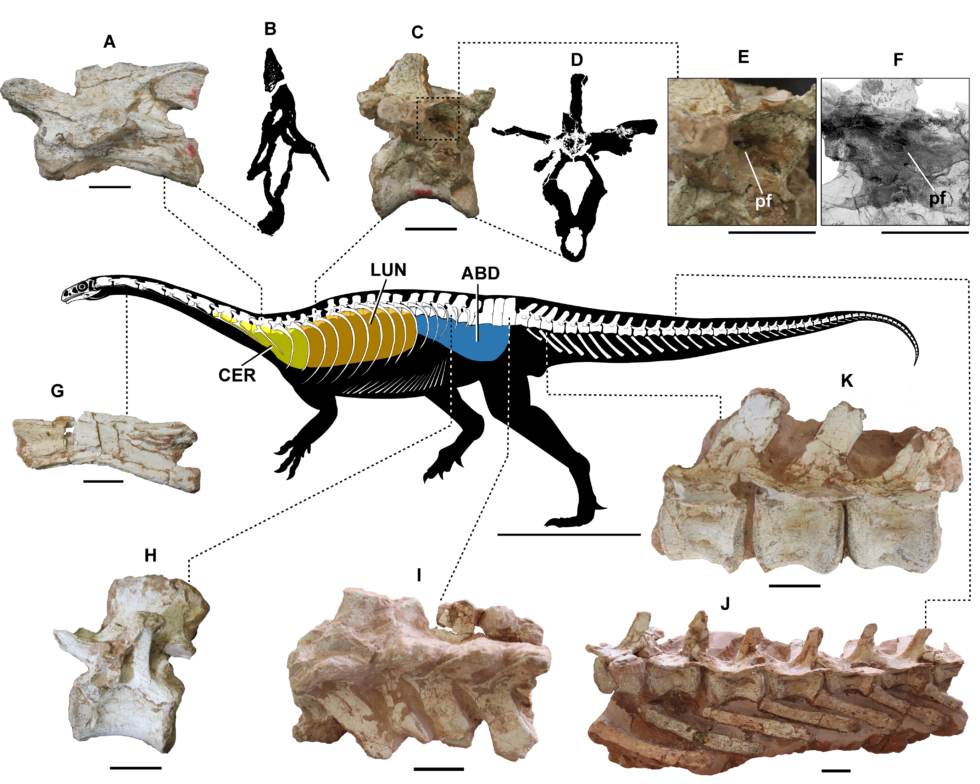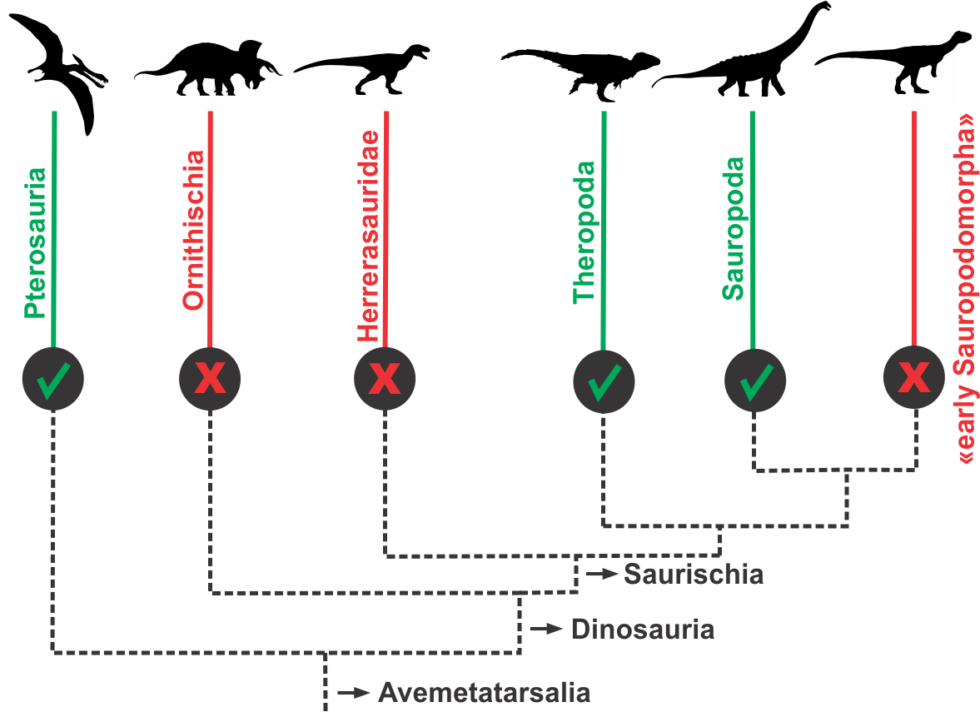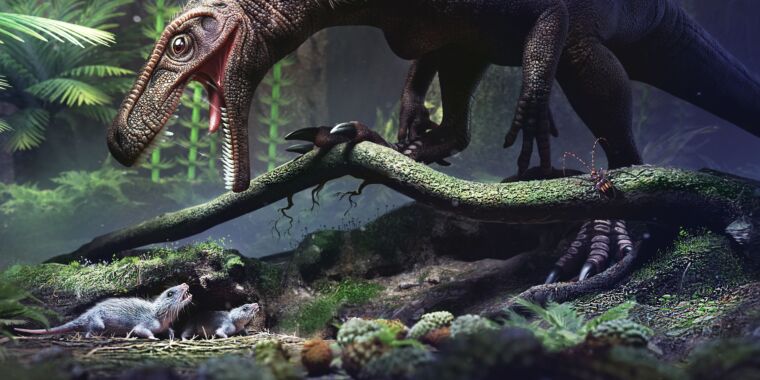
Somewhere in Earth’s past, some branches on the tree of life adopted a body plan that made breathing and cooling down considerably more efficient than how mammalian bodies like ours do it. This development might not seem like much on the surface, until you consider that it may have ultimately enabled some of the largest dinosaurs this planet has ever known. It was so successful that it was maintained by three different groups of extinct species and continues to exist today in the living descendants of dinosaurs.
Because lungs don’t usually survive fossilization, one might wonder how scientists are able to ascertain anything about the breathing capabilities of extinct species. The answer lies within their bones.
In a suite of papers published in late 2022 and early 2023, paleontologists examined fossil microstructure within some of the earliest known dinosaurs to determine just how early parts of this system evolved.
Breathing efficiency
In species like birds, that system contains cavities, also known as “air sacs,” within bones located throughout the entire body. Unlike mammalian breathing, where inhaling and exhaling are two separate processes, these bones help enable unidirectional breathing: inhaling and exhaling at the same time. Known as postcranial skeletal pneumaticity, it’s part of an extraordinarily efficient system that rapidly gets oxygen into the blood and extracts heat from the body.
Today, that invasive air-sac system is known only in birds. Birds and crocodilians are archosaurs, the living relatives of non-avian dinosaurs and pterosaurs. While today’s crocodilians have unidirectional breathing through their lungs, their air handling does not extend to their bones, which do not have any air-sac cavities. A 2012 PLOS One paper examined air-sac systems in the Triassic, and the authors determined that “no crocodile-line archosaur (pseudosuchian) exhibits evidence for unambiguous” postcranial skeletal pneumaticity.
“There are no anatomical signs of any true pneumatic features that would have been related to invasive air sacs prior to the evolution of pterosaurs and saurischian dinosaurs,” Tito Aureliano, who was not part of that PLOS One research, explained of the authors’ conclusion.
Aureliano, a paleontologist at Brazil’s Universidade Federal do Rio Grande do Norte, is lead author on the three more recent papers. He explained that, as mammals, we can become breathless or overheated through intense physical activity or intense heat. Not so if you have an invasive air sac system.
When did these air sacs evolve? They’re already present from approximately 145 to 66 million years ago within Cretaceous theropods (bipedal dinosaurs that were either carnivorous or herbivorous), pterosaurs (flying reptiles), and sauropods (gigantic long-necked dinosaurs).

Thus, to find their origin, the team looked further back to the Triassic (about 252 to 201 million years ago). They studied two types of sauropodomorphs (early sauropods before they evolved long necks and enormous size) named Buriolestes and Pampadromaeus, and a type of carnivorous dinosaur known as Gnathovorax. (Whether Gnathovorax is a theropod or a herrerasaurid—a different type of dinosaur—is currently debated.)
“So the big question was,” Aureliano said in a video interview, “did the common ancestor of these three groups back there in the Triassic already have air sacs or did the air sacs originate three times independently in evolution?”
Multiple origins
Traces on fossil bone tissue matching those seen in extant birds—today’s dinosaurs—would indicate the presence of this respiratory adaptation. None of the early species contained these traces, indicating that postcranial skeletal pneumaticity hadn’t yet evolved. Which means it couldn’t have been present in the common ancestor of the dinosaurs and other major groups where it was also present.
This surprised co-author Aline Ghilardi, a paleontologist and tenured assistant professor, also at Brazil’s Universidade Federal do Rio Grande do Norte. “Since the earliest dinosaurs didn’t have the invasive pneumatic structure,” she said, “[the air sacs] had to have evolved after that. And if it evolved after that, logically, pterosaurs had to have evolved it in a parallel way.”

In other words, these results suggest that three lineages of extinct species evolved the same respiratory system independently. This phenomenon is known as convergent evolution.
But the fossils also suggested that the evolution of air sacs had started by this time. Aureliano explained that the two sauropodomorphs and the one herrerasaurid they studied lived approximately 233 million years ago, but Pampadromaeus “was collected in a bedrock that was a little bit higher,” meaning that it existed a little later in time than Buriolestes. That gap in time, although relatively small geologically speaking, presented “a huge change” in the sauropodomorph skeleton. Pampadromaeus had a new kind of tissue that the team suspects may have been a step toward the evolution of air sacs.
“The whole vasculature was different [in Pampadromaeus],” Aureliano said. “It was less dense and [had] fractals inside, very small chambers to receive blood and fat tissues.” This, he added, would make it “easier in the future for the invasive air sacs to occupy” the space created by those fractals, “because air sacs work like fractals going out of the lungs.”
Adjusting to heat
Both Aureliano and Ghilardi pointed to the hot climate during the Triassic as a potential reason this adaptation evolved. “Perhaps if your physiology [offered an] efficient body dealing with heat, you have an advantage over your competitors,” Ghilardi offered. “So perhaps air sacs favored dinosaurs over saurischians and other competitors during the Triassic. Perhaps this is the key [to] the success of the dinosaurs during [that era].”
The team turned to another type of sauropodomorph from Brazil known as Macrocollum itaquii. Macrocollum appeared on the planet “8 million years after Buriolestes, and this animal is three times as large,” Aureliano said.
That is significant, especially as the team found evidence of an air-sac system, thereby making it the earliest known dinosaur with that evolutionary adaptation. That system wasn’t found throughout the body—as it would be in its considerably larger descendants—but its existence might have been key to enabling Macrocollum’s size.
The team compared various skeletal components of early dinosaurs to later long-necked giants. They noted the absence of an air-sac system in the earliest dinosaurs, such as the aforementioned Gnathovorax, to those that had some, such as Macrocollum. By the Late Jurassic (approximately 154 million years ago), giant sauropods had air-sac systems throughout their bodies, making them less dense and more efficient at distributing oxygen and heat.
So body size and a more advanced breathing system seemed to evolve hand in hand, consistent with the idea that the latter might have enabled the former.
Evolving in parallel
Ali Nabavizadeh is a paleobiologist and clinical assistant professor of anatomy at the University of Pennsylvania School of Veterinary Medicine who was not involved in this research. He supports the conclusions found in these papers, including the idea that the system evolved three separate times. Convergent evolution is “common among vertebrates,” Nabavizadeh said.
“First of all,” he said in a phone interview, “I trust the authors. I’ve known their work for a while now. They definitely know what they’re talking about! [The] attention to detail [in their analysis] is what really draws me, because I’m very passionate about anatomical detail.”
Nabavizadeh is fascinated with the anatomy of extinct species “because it’s such a mystery! All we have are bones. A lot of my research has to do with reconstruction of musculature on the bones, but we don’t have muscles. So, I have to look at the clues [and] do a little detective work… And that’s exactly what they did in this paper. They compared the pneumatic structures in bird bones to earlier dinosaurs to see how those structures would have possibly looked in those dinosaurs.”
The ability to see inside fossil bone through microtomography—technology that enables scientists to look inside the bone in high definition using X-rays—helped make this research possible. Technology such as CT scans, computer modeling, and the study of microstructures in fossil bone have all increased over the years, Nabavizadeh said, “and that has exponentially increased our knowledge. But, at the same time, we have a long way to go! Which is exciting, right?”
For Ghilardi, the most interesting aspect of their research was what it revealed about evolution. “Sometimes,” she said, “[evolution] has different ways of achieving the same result.” She was referencing the various ways in which air-sac systems evolved in the earliest dinosaurs her team sampled to the larger, well-studied sauropods that descended from them.
In this case, rather than a linear progression of changes within the skeletal structure of these animals, evolution appeared to be “experimenting” with dinosaur adaptations. Almost as if the Triassic was a testing ground that resulted in the largest dinosaurs that ever lived in the Cretaceous.
“Evolution works as a thinker,” Ghilardi reflected, something she often tells her students. Once it learns that something has a use, it might “recycle” that adaptation again in the future. “Something such as air sacs [evolved in dinosaurs and pterosaurs] first because it helped dealing with heat. In the future, [air sacs were] useful for [flight] in birds.”
“It’s important for people around the world to know that there is plenty more to learn from fossils,” Aureliano said. “We are not even close to being done with paleontological research,” stating that paleontology is currently in its “Golden Age.” He attributes the present-day “intellectual revolution” to a collective “effort to develop science around the world,” an effort, he said, that only improves with increased diversity and inclusion, as well as further global scientific investment.

